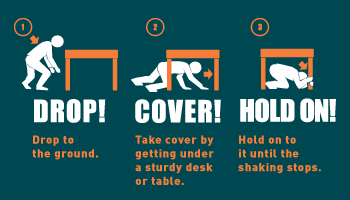Earthquake survival guide
Here’s what to do if you find yourself in the middle of the next big one.

This spring, UMKC’s Department of Geosciences took part in the Great Central U.S. ShakeOut, a multi-state earthquake drill. Organizers estimated that more than 1 million people participated in the 11-state exercise. The ShakeOut was designed to help people in the region prepare for damaging earthquakes, practice protecting themselves and prevent disasters from becoming catastrophes.
Randall Updike, B.S. ’66, regional geologist with the U.S. Geological Survey in Denver, says if you sense the ground or the building is beginning to shake, the intensity may increase from what you initially feel. So it’s critical to act instantly because the whole thing will be over in a few minutes. The first thing to consider is your location. What can fall on you? “You’re not going to die from the earthquake itself,” Updike says. “You’re going to die or get hurt from what could to fall on you. So be aware what’s around you.” Items such as light fixtures, computers, filing cabinets and brick walls can be dangerous.
Also, remember that you can’t run away from the shaking, Updike says. So the second thing you need to do is to escape from what’s falling. “Go where you feel like there’s a lot of support, like an archway or hallway,” he says. Or exit to an outdoor space—that’s the best approach. When you get outside, look around and to make sure there aren’t overhead wires and cables that could fall. Avoid elevators or anything that could trap you. If you can’t get out of where you are, dive under a table or a desk. It just may help you survive.
